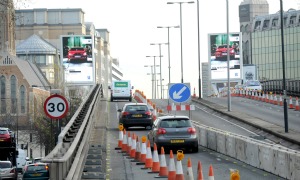The closure of Hammersmith Flyover has brought logjam to the roads in Chiswick and Brentford since Christmas despite the partial re-opening on Friday (13 Jan) to small vehicles. Large lorries and coaches are jamming up Chiswick High Road, and 9 bus routes are affected. All vehicles driving within or through west London have had to factor in longer journey times. The A4 is the major road route between Heathrow/the Thames Valley corridor and Central London, so the impact on the economy, not to mention the impression it gives to overseas visitors, is insurmountable.
Why did this happen? Could TfL have helped the Council to reduce the impact on Chiswick, Brentford and beyond? And why SHOULD the closure of one road have such a devastating impact?
TfL’s David MacNeill TfL said at yesterday’s public meeting (14 Jan) that they were caught by surprise. They had been monitoring it since the summer, but the tensioning cables that hold the bridge together started “pinging” at an unprecedented rate in December, meaning the cables would not be strong enough to cope with the pressure particularly of heavy vehicles trundling over the bridge. Reassuringly it’s probably not about to collapse, according to this technical explanation of the structure.
TfL hope to replace the cables and have the flyover fully open within 4 months – which is cutting it fine for the Olympics. David reckoned it could then have another 20 years life. Boris and the Hammersmith Tories suggest it's then replaced with a cu-and-cover tunnel, eastbound entrance - Chiswick!?In Chiswick, thanks to the prompt action of Hounslow’s Labour Council, we have:
· Converted the current 7am-7pm (and other part-time) bus lanes to 24 hour 7 day operation to maintain bus operating speeds and provide protection for cyclists.· Extended of current Monday-Saturday waiting restrictions to Monday-Sunday, and extended the evening restrictions by an hour, to 8pm
This has cost the borough in the region of £4000 plus an inordinate amount of officer time, some of it struggling to get facts and dialogue with TfL. The Council has not yet been provided with compensation for these costs. Yet we are mandated by TfL, through the strategy Local Implementation Plan to maintain bus operating speeds on key corridors.
We are very concerned that TfL’s response to the flyover closure has focussed more on protecting their Red Routes than considering the impact on local roads – there are no signs to draw vehicles away from Chiswick High Road -even when the Chiswick section of the A4 sometimes is flowing more freely than CHR. Furthermore, in encouraging people to use public transport, TfL fail to promote their own tube and Overground services in their media releases but suggest as alternative travel options as First Great Western trains!
This “crisis” caused by the closure of one key part of London’s complex road network shows how vulnerable London’s road system is to complete overload, and how wrong Boris’ pro-car policy is. West London’s traffic was mad before 23rd December – gridlock on many roads at busy times. The system is operating significantly over- capacity, closure of one element brings chaos, impacting on our lives and our economy. Every past experience shows that the more you do to accommodate rising road use, the more road congestion you get. Only a long-term vision centred around affordable public transport will achieve the much-needed modal shift. Whilst Crossrail will change London’s transport landscape, it’s not enough. We need to massively increase investment in rail, light rail etc. I seem to remember being told that 5% of journeys shifting off the roads make a massive improvement to vehicle flows on a congested road system. 5% - that’s a minority of those car drivers whose journey probably could be taken by train tube or bus. As HS2 and Crossrail show, the economic situation doesn’t stop the UK investing in major transport infrastructure, so let’s do more to improve the situation in West London –next on my list of big projects would be AirTrack, from Waterloo to Heathrow. And if Boris really wants to help the motorist, he’d pledge to invest in better public transport to create space for those who cannot or won’t get out of their cars.


No comments:
Post a Comment